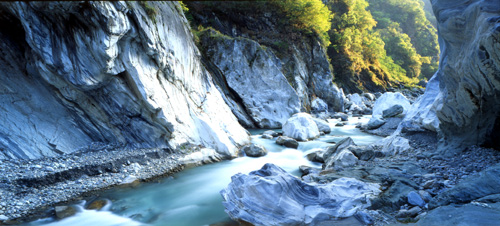Itinerary
- Pick-up at the hotel
- Transfer to Taipei domestic airport for flight to Hualien
- Arrive at Hualien and take the coach to Taroko National Park
- Chang-Chun (Eternal Spring) Shrine
- Swallows’ Grotto
- Tunnel of Nine Turns
- Tienhsiang Village (lunch at the Grand Formosa Taroko Hotel)
- Marble Factory
- Chi-Hsing Beach
- Hualien Stone Sculptural Park
- Back to Taipei
- Transfer to the hotel
Taroko is one of the seven wonders of Asia, and it is also the second largest national park in Taiwan. Taroko is famous for its spectacular mountains and marble canyons. Cliffs and canyons stretch along the Li Wu River. Four million years ago, the island of Taiwan was formed by the collision of plates; after millions of years of wind erosion, the marble rocks were exposed and cut by the Li Wu River, creating impressive grand canyons. From Tsing Shui to Nan Hu Peak, the drop in elevation is 3,742 meters. Such special geography has also become home to special flora and fauna.
Among the famous waterfalls which characterize Taroko National Park are the Pai Yang Waterfall, the Yin Tai Waterfall, the Chang Chun Waterfall, and the Lu Shui Waterfall. Yen Tze Kou (the Swallows’ Grotto) and Chiu Chu Tung are the most impressive natural scenes in Taroko; the canyons here are the narrowest. Tourists can appreciate the natural beauty along the tour track. Swallows nest on the cliff, chirping and flying back and forth. The Taroko monument is designed in Chinese style and Chang Chun Temple is a memorial to those who sacrificed their lives in the building of the central highway.
After a 25-minute flight from Taipei to Hualien, you will be guided along a 12-mile stretch of highway built into awesome marble cliffs high above the rushing river. Your route will take you through 38 tunnels including the Swallows’ Grotto, the Tunnel of Nine Turns and the Marble Bridge of Motherly Devotion. After lunch you will visit Chi-Hsing beach and the Stone Sculptural Park. The train back to Taipei is scheduled at around 4:30 PM.
* The above article and pictures are from the Taiwan Tourism Bureau and the Taroko National Park. Please visit the websites for more detailed information.









